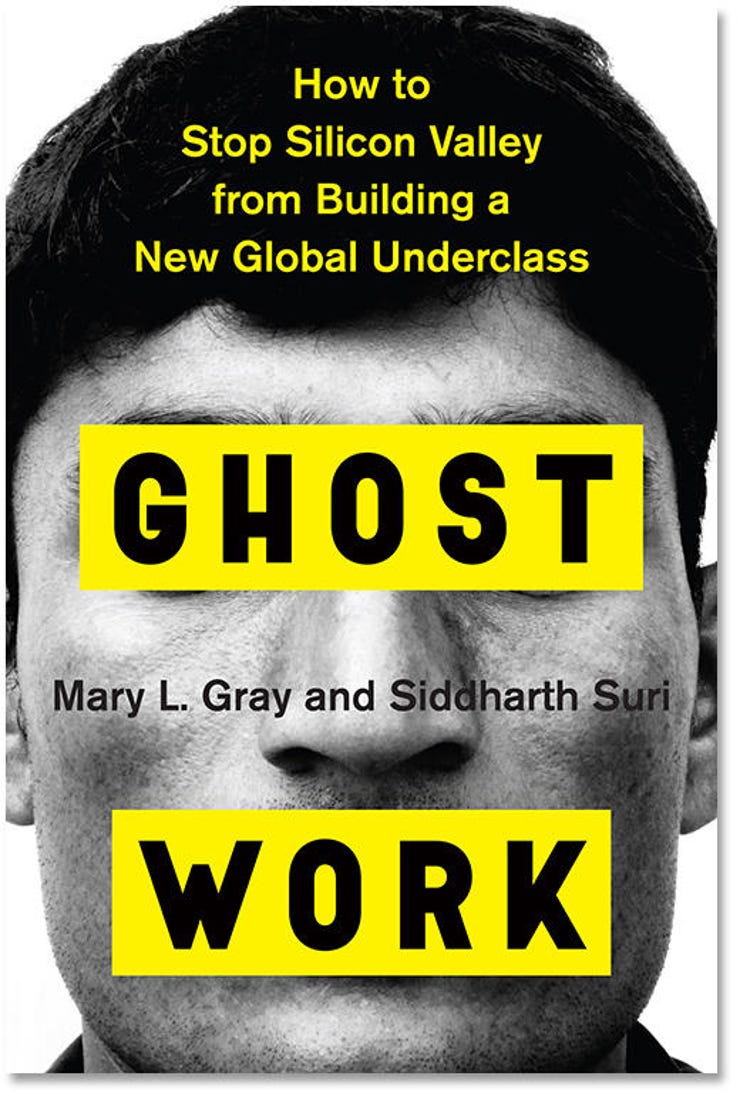Ghost Work and Behind the Screen, book reviews: Lifting the veil on the internet's secret employment sector


Ghost Work • By Mary L. Gray and Siddharth Suri • Houghton Mifflin • 288 pages • ISBN: 978-1-328-56624-9 • $27
The technology industry loves nothing better than to dress up something old in idealistic language and offer it up as a bright, new benefit. Flea markets existed long before eBay consolidated them into a website; clubs shared cars and friends surfed each other's couches long before Uber and Airbnb 'invented' the 'sharing economy'; and task-based employment existed for centuries before platforms like CrowdFlower, CloudFactory, and Amazon's Mechanical Turk began touting the flexibility of on-demand micro-employment. It was known as 'piecework', and it was associated with poverty and exploitation.
The platforms talk a good game. Workers, they argue, like the flexibility and control over their time and the convenience of working at home without the time sink of commuting and the constraints of traditional workplaces. In Ghost Work, the results of a five-year study of platform workers in the US and India, Mary L. Gray and Siddharth Suri find that all these things are true for many of the workers they interview -- but they are only part of the picture.
For one thing, most of the task platforms are designed to remove the personal connections of traditional workplaces. 'Requesters' -- 'employer' implies the legal and contractual relationship that all these companies deliberately avoid -- don't need to know anything about their labourers beyond the rating the API assigns their work. For some -- a disabled man facing discrimination, for example, or a woman whose culture frowns on her working outside her home -- that anonymity is a blessing. On these platforms, nobody knows you're a dog -- but nobody knows you're a human, either, and the downside is what web designer Eric Meyer has called "inadvertent algorithmic cruelty". The lack of empathy encoded into the platforms' APIs means that someone who suffers because their account is wrongly suspended gets no compensation and no certainty it won't happen again.
Behind the Screen: Content Moderation in the Shadows of Social Media • By Sarah T. Roberts • Yale University Press • 266 pages • ISBN: 978-0-300-23588-3 • $30
Gray and Suri call it 'ghost work' because this huge labour market is being rendered as invisible as housework by the claim -- which Janelle Shain has also noted -- that AI is these companies' special sauce. Neither riders nor drivers know, for example, that while a rider awaits her Uber car a woman named Ayesha in Hyderabad has a clock ticking down the seconds while she compares the driver's live photo to his on-file ID because shaving off his beard has led the system to flag him as a possible imposter.
Imperceptible intermediations like this one happen in 1% of Uber rides, Gray and Suri write, and can be found throughout "automation's last mile". Technology companies like to parade the size of their AI muscles, but the hidden reality is millions of tiny gigs being carried out by humans on a freelance or contingent basis.
Lifting the veil on this secret employment sector is hard because the technology companies want to pretend it doesn't exist. Gray and Suri go directly to the workers themselves by using the platforms themselves to recruit them. Sarah T. Roberts also goes direct to the source after her curiosity about content moderation was piqued by a newspaper article in 2010. In Behind the Screen, Roberts presents the results of her eight-year study of one particular category of ghost workers: commercial content moderators, the people who review the online postings we're not supposed to see.
Roberts finds four styles of employment in this business: in-house teams (often lacking the status and benefits we associate with the technology giants); 'boutique' third parties offering a specialised service; large, call centre-style operations; and micro-labour platforms like those described by Gray and Suri in Ghost Work.
Those who work in these jobs may be reviewing items as mundane as phone numbers on a dating site (barred to keep users from costing the site revenue by making direct contact) and as loathsome as child abuse imagery and decapitation videos. They are generally governed, like Gray's and Suri's workers, by metrics rating their speed and productivity. Make no mistake, this is hard work: could you accurately process more than 150 items an hour? (This aspect of Roberts' reporting makes me think of the 1920s song 'Keep That Wheel A-Turning', in which the threat of unemployment forces worker William Brown to keep increasing his speed.)
SEE: Sensor'd enterprise: IoT, ML, and big data (ZDNet special report) | Download the report as a PDF (TechRepublic)
More than that, could you stand the steady stream of horrifying imagery? One of Roberts' contacts, a third-party contractor at a Silicon Valley giant she styles 'Megatech', tells her horror movies are 'ineffective' after months of this work. And it is months, because within a year they are replaced, either to ensure no-one does this work for too long or to ensure they don't come to qualify for higher employment status.
Regulation required
Roberts argues that understanding how content moderation really works is crucial for understanding how the internet works. For the foreseeable future, content moderation at scale is going to require thousands of humans -- far from the AI that companies would rather you imagine. Acknowledging their existence is the first step to treating them better. She concludes by discussing the possibility that the technology companies should take on both liability for content and legal liability for employees.
Gray, and Suri also head in the direction of regulation: this growing workforce needs the protections their employers are trying to avoid and the social support that traditionally came with work. No public debate has accompanied the rise of the task-based economy, which the World Bank projects to be a $25 billion market in 2020, nor have we begun to consider the threat it poses to the rights that workers have fought for.
We should decide as a society what we want ghost work to look like, Gray and Suri conclude. For their US-based target audience, they recommend that hiring companies should: support collaboration, social spaces for workers, and shared workspaces; enable resumé and rating portability to provide career trajectories; and build empathy into automated controls. More broadly, society should adopt universal healthcare, paid family leave, municipal co-working spaces, and continuing education.
RECENT AND RELATED CONTENT
Tim Cook's dream: Every enterprise run on an iPhone
Top ten tech turkeys 2019: The year's absolute worst product and service failures
Wikipedia's Jimmy Wales has quietly launched a Facebook rival social network
IBM boss Ginni Rometty urges businesses to widen the hiring pool to fill skills gap
Work less but produce more? In Japan, Microsoft is trying to solve that puzzle
Read more book reviews
- Fire, Ice and Physics, book review: The facts behind the fantasy
- You Look Like a Thing and I Love You, book review: The weird side of AI
- Permanent Record, book review: The whistleblower's tale
- The Big Nine, book review: Visions of an AI-dominated future
- Tools and Weapons, book review: Tech companies, governments and smart regulation